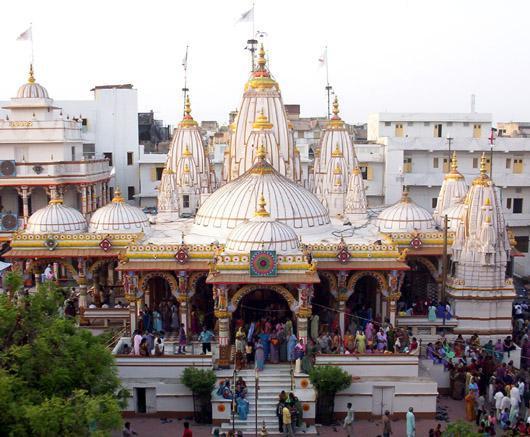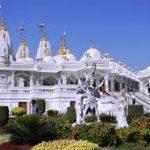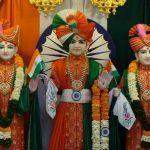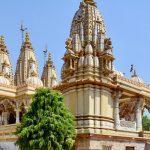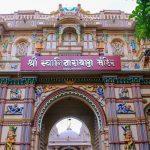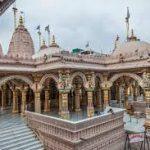Contents
Swaminarayan Temple, Ahmedabad, Gujarat
| Date built: | 24 February 1822 |
|---|---|
| Deity: | – |
| Architectural style: | – |
| Major festivals | – |
| Locale: | – |
| District:: | Ahmedabad |
| Address: | Swaminarayan Mandir Road, Kalupur, Ahmedabad, Gujarat 380001 |
| Phone | 07922132170 |
Shree Swaminarayan Mandir Kalupur (Gujarati: શ્રી સ્વામિનારાયણ મંદિર, અમદાવાદ, Devnagari: श्री स्वामिरायण मन्दिर, अहमदाबाद) is the first temple of the Swaminarayan Sampraday, a Hindu sect. It is located in Kalupur area of Ahmedabad, the largest city in Gujarat, India. It was built on the instructions of Swaminarayan Bhagwan, the founder of the sect.
As per the will of Swaminarayan, the administration of the Swaminarayan Sampraday is divided into two Gadis (seats) – NarNarayan Dev Gadi and LaxmiNarayan Dev Gadi. This temple is the headquarters of the NarNarayan Dev Gadi. Green and yellow sculptures of Hindu gods and goddesses, their bodies fitted in opulent dress, cover the structure of this nineteenth-century temple.
With its architecture based on Burma teak wood, every coloured arch and bracket is a bright different shade, something that stands out in most Swaminarayan temples. According to Anjali Desai, author of India Guide Gujarat, the temple resembles a fairytale with all its colours and opulent carvings that profusely embellish every wooden bracket, column and arch. The temple attracts a million people on the day after Diwali. The temple has a multi-story guesthouse that is air conditioned and has a fully equipped medical clinic within its compound.
Architecture
Central Gateway
The central gateway of the temple is artistic. It blends local, regional and British styles of architecture and sculpture. Marathi and Rajasthani folk cultures and costumes are evident on the gateway sculptors. The columns are engraved with vertical lining in Corinthian order. The top of the projected pavilions are ruminants of Mughal architecture. Statues of the women wearing frilled blouses and petticoats, carrying their kids on their waist depict the Gujarati women.This central gate is made without taking any kind of measurements.
Nar Narayan Temple
This is the heart of the temple complex. The temple was constructed as per scriptural norms with intricate carving in pure Burma-teak and constructed with sculptural art by depicting deities’ episodes, auspicious symbols and religious icons representing axiomatic religion and Indian culture. The temple is believed to be a valuable cultural heritage in the socio-religious history of Gujarat and India. The images in this temple are of Narnarayan Dev in the centre, Radhakrishna Dev on the right, Dharmadev, BhaktiMata and Harikrishna on the left of the central hall. The images were made in Dungarpur and stone came from quarries in Himmatnagar and Dhrangadhra. The temple is also known for the attractive dresses that drape the deities. Dresses for the central Narnarayan as well as RadhaKrishna images are changed seven times a day and are never repeated.
Akshar Bhavan
Inside the temple
Besides the gods in the main temple, an idol in the form of a child, Ghanshyam Maharaj in white marble has been installed on the ground floor. Personal items of Swaminarayan have been displayed for viewing by the visitors on the ground as well as first floor. The southern side of this building is known as Shree Tejendra Bhuvan and houses visiting pilgrims.
Rang Mahol
An idol of Ghanshyam Maharaj has been installed in a place called the Rang Mahol in the temple where Swaminarayan stayed during his visits to Ahmedabad. A wood carved life-size idol of Swaminarayan in standing sambhang position, was installed here fifty years after the construction of the temple. It is one of the finest specimens of wooden art sculpting in Gujarat.
Temple for women (West)
The Haveli (Mansion) to the west of the temple used to be the official residence of Acharya of the Narnarayan Dev Gadi. Now, the ground floor of the front side, houses the offices and the inner portion accommodates the residency of the Samkhya Yogi women (ladies who have taken celibacy vows and devoted their life to the temple). In the inner temple, the Gadiwalla (the Acharya Maharajshri’s wife & spiritual leader of the women in the Swaminarayan Sampraday) holds religious assemblies solely for the benefit of the women. An idol of Ghanshyam Maharaj has been installed in this temple and is served by the Sankhya Yogi women devotees.
This mansion is decorated with chandeliers, suspended lamps and large mirrors as it was supposed to be the residence of the Acharya. The brackets of the pillars in the portico as well as arches have been adorned with carvings in geometrical designs and a variety of flower and creeper motifs.
The wood sculptured haveli
Haveli (North)
This three-storey mansion was constructed by Acharya Maharjshree Keshavprasadji Maharaj in 1871.
The mansion itself rests on octagonal and square wooden pillars on which Ardh-murt relief sculpture of flowers and creepers is engraved. Angles of wooden pillars, carved in free hand design and the shapely Bharnai, which balconies rest on. The Sabha mandap, an extensive Central Hall, has been constructed on sixty pillars. There are giant size madal-shilp sculptures on twelve high pillars in the front row on which rest the portico of the first floor, capture our attention with its great artistic appeal. These sculptors include a flying Hanuman lifting the Devgiri mountain in his palm; a pot bellied Ghanesha wearing a scarlet turban in the South Indian style, miniature sculptures of several soldiers armed and dressed in Marathi turbans and costumes and herds of monkeys have been created on the religious tradition in the wooden sculptors. Some sculptors depict the 1857 uprising, with the Rani of Jhansi and other heroes narrated in carvings of these pillars. There are a total of 12 such pillars, which depict scenes such as a Maratha warrior fighting under the Rani of Jhansi in guise of Durga the Hindu goddess, Indian leader Tatya Tope in the guise of Narsimha, the lion headed form of Vishnu and that of parrots which tell the mood of the times.
Sculptures of lions and elephants, birds like peacocks and parrots and perfectly engraved leaves and flowers decorate the panels. The beams, ceilings, and lower sections are adorned with engravings, artistic sculptures and free-hand designs. In this mansion, Acharya sits on the wooden seat once used by Swaminarayan in the Congregation Hall. A new residence of the saints, Vrajendraprasad Mahal and a dining hall for the devotees are also situated in this mansion.
Haveli (East)
This mansion is two storeyed. Sculptures of animal heads, flowers and creepers are carved on the wooden pillars of the portico on the ground floor. Items relating to NarNarayan Dev on the ground floor. The first and second floors house a Sanskrit and music school as well as residence for saints. The backyard hosts the residence for brahmchari(celibate) students. A well where Swaminarayan used to bathe under a dome is also part of the backyard.
Legend / Local stories
The land for construction of this first shrine of Swaminarayan Sampraday, was given by the British Imperial Government in India to Swaminarayan. The task of constructing this temple was entrusted personally by Swaminarayan to Ananandanand Swami (a paramhansa of the sect).The installation ceremony of the murti(images) in the temple was celebrated in the presence about 50,000 of pilgrims representing many parts of India.
Relations with the British Government
A British officer, Sir Dunlop was so impressed with activities of Swaminarayan and his followers, that on behalf of the government he gave 5,000 acres (20 km2) of land in Kalupur area of Ahmedabad to build this temple. When the temple was completed, the officer was so impressed by the temple that he commanded a 101 gun salute to the temple.
When the British government wanted to build a railway station in Kalupur, the temple returned part of the land, where Kalupur Railway Station stands today. The government compensated the temple by granting it 1,000 acres (4.0 km2) of land in the Narayannagar village. Although the temple had very good relations with the British government, part of the wooden carvings in the temple depict the 1857 uprising, which is often referred to as India’s first war of Independence.
Photo Gallery
How to Reach:
Contact Details
Official Address

